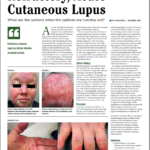 Results from a phase 2 trial of patients with cutaneous lupus erythematosus revealed that treatment with litifilimab was superior to placebo for reducing skin disease activity at 16 weeks. The study focused on cutaneous lupus erythematosus, an autoimmune disease that can occur in the presence or absence of systemic lupus erythematosus (SLE). The study by Victoria P. Werth, MD, chief of dermatology at the Philadelphia Veterans Association Hospital, and colleagues, was published in the New England Journal of Medicine in July 2022.1
Results from a phase 2 trial of patients with cutaneous lupus erythematosus revealed that treatment with litifilimab was superior to placebo for reducing skin disease activity at 16 weeks. The study focused on cutaneous lupus erythematosus, an autoimmune disease that can occur in the presence or absence of systemic lupus erythematosus (SLE). The study by Victoria P. Werth, MD, chief of dermatology at the Philadelphia Veterans Association Hospital, and colleagues, was published in the New England Journal of Medicine in July 2022.1
Cutaneous lupus erythematosus can cause irreversible damage and disfigurement, impair quality of life and is associated with depression, anxiety and fatigue. Cutaneous lupus erythematosus manifests in several major subtypes: chronic, subacute and acute. Most patients with subacute or chronic cutaneous lupus erythematosus will not develop SLE.2
Methods
The randomized, placebo-controlled trial included 132 patients with active, histologically confirmed cutaneous lupus erythematosus with or without SLE manifestations. The investigators measured skin disease activity using the Cutaneous Lupus Erythematosus Disease Area and Severity Index-Activity (CLASI-A) score and evaluated the efficacy of litifilimab. Litifilimab is a humanized monoclonal antibody that binds blood dendritic cell antigen 2 (BDCA2), which is a receptor exclusively expressed on plasmacytoid dendritic cells. Patients were randomized receive placebo (n=33), 50 mg of litifilimab (n=26), 150 mg of litifilimab (n=25) and 450 mg of litifilimab (n=4).
Although approximately 90% of patients received concomitant background therapy, including oral glucocorticoids (prednisone at a dose ≤15 mg per day or equivalent), antimalarial drugs and immunosuppressant agents, most trial participants had moderate to severe disease with mean CLASI-A scores of 15.2 for the placebo group, 18.4 for the 50 mg litifilimab group, 16.5 for the 150 mg litifilimab group and 16.5 for the 450 mg litifilimab at baseline group.
The Results
At week 16, treatment with litifilimab improved CLASI-A scores compared with placebo. The difference in the change from baseline compared with placebo was -24.3 percentage points (95% confidence interval [CI], -43.7 to -4.9) for 50 mg of litifilimab, -33.4 percentage points (95% CI, -52.7 to -14.1) for 150 mg of litifilimab and -28.0 percentage points (95% CI, -44.6 to -11.4) for 450 mg of litifilimab. The investigators used the least squares mean changes in the primary analysis of a best-fitting, dose-response model across the three drug-dose levels and placebo, finding a significant effect.
The researchers found most of the secondary end points did not support the results of the primary analysis. These secondary end points included a decrease of at least 50% from baseline in the CLASI-A score at weeks 12 and 16, the percent change in baseline in the CLASI-A score at week 12, reductions from baseline in the CLASI-A score of at least four points at weeks 12 and 16 and of at least seven points at weeks 12 and 16, and changes in pharmacokinetic measures.
Discussion
The authors acknowledged that patients who received litifilimab may be at increased risk of infections. In their study, they identified three cases of oral herpes infection and one case of herpes zoster infection. Additionally, one case of herpes zoster meningitis occurred four months after the patient received their last dose of litifilimab. The investigators also documented three cases of hypersensitivity.
Absent approved treatments for cutaneous lupus erythematosus, rheumatologists typically treat patients with topical glucocorticoids and antimalarial medications.3 Unfortunately, limited evidence exists regarding the benefit of glucocorticoids, and a 2017 meta-analysis found that responses to antimalarial medications on skin manifestations may vary widely.4
“This has been an interesting study because it really focuses on patients with unmet needs,” says Nathalie Franchimont, MD, PhD, chief medical officer for Nimbus Therapeutics in Cambridge, Ma., and corresponding author for the paper.
The published results come from part B of a larger study. The investigators published results from part A of the study in September.5 The second analysis found that litifilimab was associated with a greater reduction in the number of swollen and tender joints from baseline than placebo over a period of 24 weeks.
The team has begun two concurrent phase 3 clinical trials (TOPAZ-1 and TOPAZ-2), which are designed to evaluate the efficacy and safety of a year of treatment with litifilimab compared with placebo in patients with active SLE. Trial participants will also receive background lupus standard of care therapy. TOPAZ-1 and TOPAZ-2 are enrolling up to 540 participants at multiple sites worldwide.
Lara C. Pullen, PhD, is a medical writer based in the Chicago area.
References
- Werth VP, Furie RA, Romero-Diaz J, et al. Trial of anti-BDCA2 antibody litifilimab for cutaneous lupus erythematosus. N Engl J Med. 2022 Jul 28;387(4):321–331.
- Gronhagen CM, Fored CM, Granath F, et al. Cutaneous lupus erythematosus and the association with systemic lupus erythematosus: A population-based cohort of 1088 patients in Sweden. Br J Dermatol. 2011 Jun;164(6):1335–1341.
- Kuhn A, Aberer E, Bata-Csorgo Z, et al. S2k guideline for treatment of cutaneous lupus erythematosus – guided by the European Dermatology Forum (EDF) in cooperation with the European Academy of Dermatology and Venereology (EADV). J Eur Acad Dermatol Venereol. 2017 Mar;31(3):389–404.
- Chasset F, Bouaziz J-D, Costedoat-Chalumeau N, et al. Efficacy and comparison of antimalarials in cutaneous lupus erythematosus subtypes: A systematic review and meta-analysis. Br J Dermatol. 2017 Jul;177(1):188–196.
- Furie RA, van Vollenhoven RF, Kalunian K, et al. Trial of anti-BDCA2 antibody litifilimab for systemic lupus erythematosus. N Engl J Med. 2022 Sep 8;387(10):894–904.

